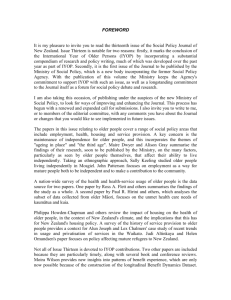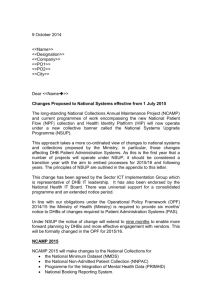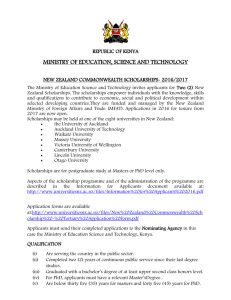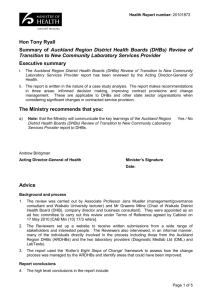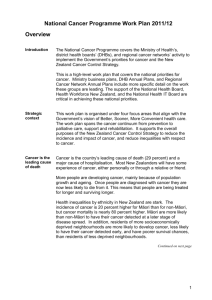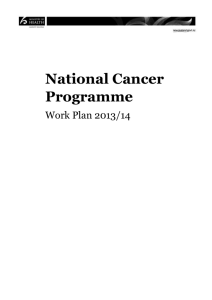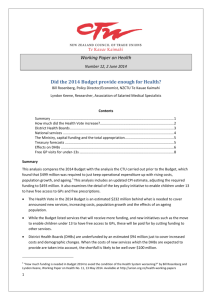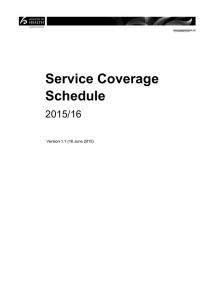National Cancer Programme for 2012/13
advertisement
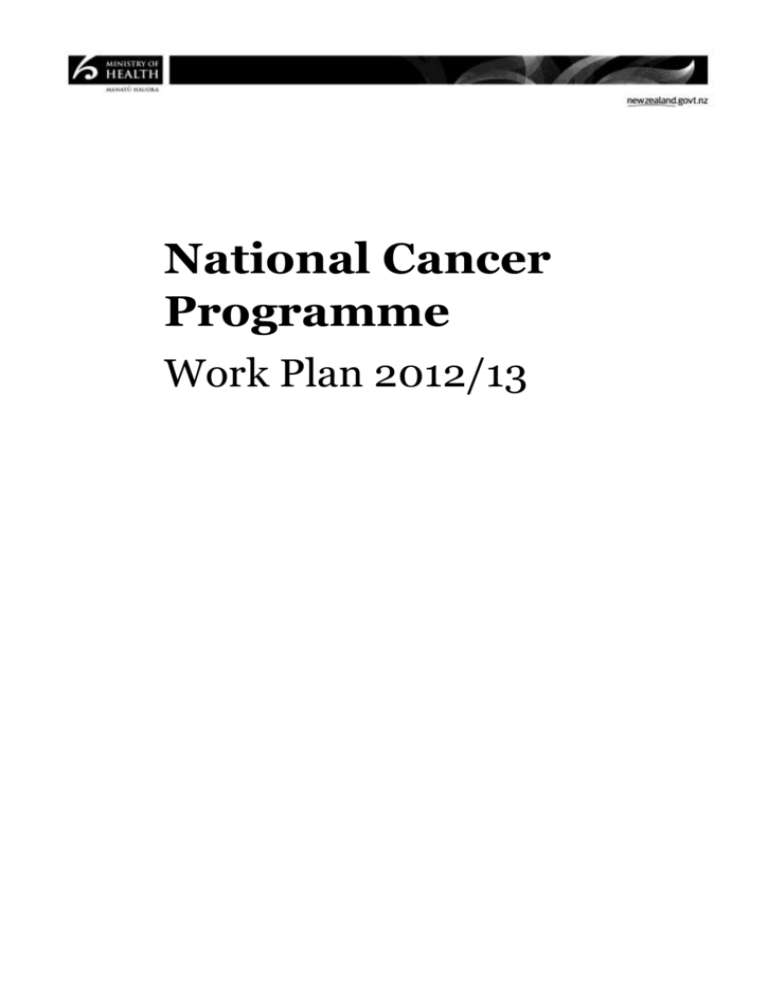
National Cancer Programme Work Plan 2012/13 Citation: Ministry of Health. 2013. National Cancer Programme: Work Plan 2012/13. Wellington: Ministry of Health. Published in January 2013 by the Ministry of Health PO Box 5013, Wellington 6145, New Zealand ISBN 978-0-478-40243-8 (online) HP 5614 This document is available at www.health.govt.nz Contents Overview 1 Introduction 1 Strategic context 1 Cancer is the leading cause of death 1 Survival ratios are improving 2 Health care costs are rising 2 Priority areas have been identified to provide better and faster services for cancer patients 3 National Cancer Programme for 2012/13 4 Work Plan 2012/13 5 Key work plan initiatives 5 Wait times: all people get timely services 5 Access: all people have access to services that maintain good health and independence 7 Quality: all people receive excellent services wherever they are 8 Financial sustainability: All services make the best use of available resources 9 National Cancer Programme: Work Plan 2012/13 iii Overview Introduction The National Cancer Programme brings together the work of the Ministry of Health (the Ministry), district health boards (DHBs) and regional cancer networks to implement the Government’s priorities for cancer. This high-level work plan for 2012/13 covers the national priorities for cancer. Ministry business plans, DHB annual plans and regional cancer network annual plans include more specific detail on the work these groups are leading. The National Cancer Programme is an integrated work programme. At a national level the Ministry team works with the National Health Board, Health Workforce New Zealand and the National Health IT Board to improve the coordination of health sector planning and service delivery, and achieve the National Cancer Programme priorities. While this work plan focuses on cancer-related initiatives, there are established links between the delivery of this work plan and initiatives being led by the National Health Board, Health Workforce New Zealand and the National Health IT Board. Strategic context The National Cancer Programme Work Plan is organised under four focus areas aligning with the Government’s vision of Better, Sooner, More Convenient Health Care. The work plan supports the overall purpose of the New Zealand Cancer Control Strategy to reduce the incidence and impact of cancer, and reduce inequalities with respect to cancer incidence and mortality. Cancer is the leading cause of death Cancer is the country’s leading cause of death (29 percent) and a major cause of hospitalisation. Most New Zealanders will have some experience of cancer, either personally or through a relative or friend. The incidence of cancer is 20 percent higher for Māori than for non-Māori, but cancer mortality is nearly 80 percent higher for Māori. Māori are also more likely than nonMāori to have their cancer detected at a later stage of disease spread. Residents of more socioeconomically deprived areas are more likely to develop cancer, less likely to have their cancer detected early, and have poorer survival than residents of less deprived areas. National Cancer Programme: Work Plan 2012/13 1 While the overall risk of developing cancer in New Zealand is decreasing, New Zealand has an increasing number of people who are developing cancer, mainly because of population growth and ageing. The total number of cancer registrations is projected to increase by approximately 21 percent from 2006 to 2016. In addition, once people are diagnosed with cancer they are now less likely to die from it. This means that people are surviving longer, and being treated for longer periods of time, with different treatments. Survival ratios are improving The Ministry’s most recent cancer survival publication (2012) shows that between 1994 and 2009, the five-year cumulative relative survival ratios showed statistically significant improvement for adults (both males and females).Survival increased for both Māori and non-Māori, however the Māori increase was not statistically significant. The Organisation for Economic Cooperation and Development (OECD) Health Care Quality Indicators Data 2009 used three cancers as indicators of how well countries were delivering cancer care (breast, cervical and colorectal cancer). The indicators showed New Zealand’s relative survival ratios for all three cancers were above the OECD average. The OECD data also showed improved survival rates for patients with breast and cervical cancer from 2002 to 2007 compared to 1997 to 2002 (the data was unavailable for colorectal cancer). Health care costs are rising Overseas studies indicate that cancer costs are likely to increase at a faster rate than overall health expenditure. As the population ages, the total number of people treated for cancer will increase at a faster rate than the overall population. Costs are also likely to increase as new, more advanced and more expensive treatments are adopted. The Ministry (based on 2008 registrations and 2008/09 prices) estimates that $511 million per year was spent on cancer treatment services by the publicly funded New Zealand health system. This represented about six percent of the total public health expenditure, which is in line with estimates from the United States and Australia.1 1 2 This estimate does not include costs borne by individuals, insurance-funded or out-of-pocket expenditure in the private system, expenditure by non-government organisations (NGOs) supported by charitable funding, the value of volunteer contributions, and expenditure on research. It also does not include the cost of preventive or screening programmes. The two national screening programmes, BreastScreen Aotearoa and the National Cervical Screening Programme, currently cost approximately $80 million per annum. The estimate does not consider the costs of morbidity and mortality nor the savings that might result from reduced morbidity and mortality. National Cancer Programme: Work Plan 2012/13 By 2021, the Ministry estimates public expenditure on cancer treatment services will increase by an additional $117 million (23 percent). This estimate is based on current models of care and projected cancer incidence growth. The estimated expenditure does not adjust for the impact of new technologies, improved survival, reduced mortality or earlier detection of some cancers. As a result the estimated expenditure for 2021 is likely to be an underestimation. Priority areas have been identified to provide better and faster services for cancer patients Budget 2012 is delivering an additional $33 million in operating funding over the next four years for better and faster services for cancer patients. The $33 million includes funding for dedicated nurses, who will coordinate care and support individual patients during their cancer treatment. From 1 July 2012, DHBs will collect data at key points along each cancer patient’s clinical journey to begin measuring the length of time it takes for patients to track through the diagnostic and treatment pathway. The Budget 2012 ‘Faster cancer treatment initiative’ builds on the success of the ‘Shorter waits for cancer treatment’ health target that has focused on radiotherapy wait times. From 1 July 2012 chemotherapy wait times was also included in the health target. In Budget 2010 the Government prioritised funding for a four-year bowel screening pilot (undertaken in the Waitemata DHB region) to inform future decisions on whether bowel screening should be rolled out nationally. To support a possible national roll-out of bowel screening, a quality improvement programme is being implemented to support endoscopy service provision. A key feature of this work is the Global Rating Scale (GRS), a web-based tool that allows endoscopy units to self-assess against a set of standards. The GRS tool is currently being trialled at four DHBs (Waitemata, Lakes, Wairarapa and Canterbury). The Government is committed to improving national and regional planning of services, improving essential infrastructure, and improving clinical leadership and engagement. The projects over 2012/13 that address this include: implementing a new model of care for medical oncology national service planning for radiation oncology services developing a quality improvement plan for prostate cancer. Budget 2009 provided additional funding for hospices as part of the Government’s commitment to improving access to essential palliative care services. The Budget also provided funding to widen access to Herceptin (drug used in the treatment of breast cancer). The diagram below shows how cancer programme priorities link to the Government’s priorities. National Cancer Programme: Work Plan 2012/13 3 National Cancer Programme for 2012/13 4 National Cancer Programme: Work Plan 2012/13 Work Plan 2012/13 Key work plan initiatives Over 2012/13 DHBs, the Ministry and regional cancer networks will deliver the following initiatives in each of the four focus areas. The lead agency is named under each initiative. Wait times: all people get timely services The Government is committed to Better, Sooner, More Convenient Health Care. For the National Cancer Programme this means improving access to, and shorter waiting times for cancer treatment. Key performance indicators Initiatives Everyone needing radiation Report against the ‘Shorter waits for cancer treatment’ target treatment or chemotherapy will on a monthly basis. have this within four weeks. Undertake national radiation oncology capital and service planning by June 2013. Planning will provide national direction to DHBs on future service requirements to support DHBs to sustainably meet the health target. It will also update previous plans. Implement phase one of the medical oncology models of care plan by June 2013. A new model of care for medical oncology has been developed to ensure services can effectively, equitably and sustainably meet future demand, given workforce and resource trends. Over 2012/13 the priority areas are: workforce (senior medical officers and nursing) service configuration (assessing the new model against current service provision) quality standards across tumour streams. Lead: The Ministry, DHBs National Cancer Programme: Work Plan 2012/13 5 Key performance indicators Initiatives Baseline reporting against three Implement the faster cancer treatment work programme. new faster cancer treatment 1. Appoint cancer nurse coordinators across all DHBs by pathway indicators: June 2013. 62 day indicator – all The cancer nurse coordinators will act as a single point patients referred urgently of contact and assist patients and their families across with a high suspicion of different parts of the health service, ensuring care is cancer receive their first coordinated and appropriate support is provided. cancer treatment (or other management) within 62 days 2. Develop treatment standards across eight tumour types 14 day indicator – all by June 2013. patients referred urgently Treatment standards aim to improve overall care by with a high suspicion of ensuring consistency of care. Nationally developed cancer have their first standards will be implemented regionally. The specialist assessment within standards will be used to develop key performance 14 days indicators that will be audited and used to drive 31 day indicator – all improvement in services. patients with a confirmed 3. Report baseline data against the three faster cancer diagnosis of cancer receive treatment indicators by March 2013. their first cancer treatment (or other management) Reporting against these indicators will provide within 31 days of the information to support service improvement so that decision-to-treat. patients have faster access to a specialist once cancer is suspected, and then faster access to treatment once there is a confirmed diagnosis. Lead: The Ministry, regional cancer networks, DHBs 6 National Cancer Programme: Work Plan 2012/13 Access: all people have access to services that maintain good health and independence Reducing risk factors and improving early diagnosis contribute to reducing the incidence of cancer and improving survival rates. The National Cancer Programme is focused on ensuring people have access to smoking cessation advice and participate in appropriate screening programmes. Key performance indicators 95 percent of patients who smoke and are seen by a health practitioner in public hospitals will be offered brief advice and support to quit smoking. Initiatives Implement the ABC approach for smoking cessation in the hospital and primary care settings. The ABC approach is: Ask all people about their smoking status provide Brief advice to stop smoking to all people who smoke 90 percent of patients who smoke and are seen by a health practitioner in primary care will be offered brief advice and support to quit smoking. offer evidenced-based Cessation treatment. Lead: DHBs and primary health organisations Progress will be made towards 90 percent of pregnant women who smoke being offered advice and support to quit. Monitor the bowel screening pilot, including finalising the service delivery model and the interim quality standards by December 2012. Update the service delivery model with Waitemata DHB by December 2012. Migrate all BreastScreen Aotearoa lead providers from provision of analogue to digital mammography by December 2013. Complete national procurement process of digital equipment by August 2012 to ensure value for money for equipment purchased. Implement centralised Picture Archiving Communication System (PACS). Centralise the information system for all BreastScreen Aotearoa lead providers. Finalise the interim quality standards by December 2012. Lead: The Ministry and Waitemata DHB Lead: The Ministry, BreastScreen Aotearoa lead providers Increase cervical screening coverage2 to 80 percent for all ethnic groups by 30 June 2014. Monitor the National Cervical Screening Programme against national standards, indicators and targets. Implement the recommendations of Parliamentary Review Committee (June 2011 Report). Lead: The Ministry 2 Women aged 20 to 69 years screened in the previous three years. National Cancer Programme: Work Plan 2012/13 7 Quality: all people receive excellent services wherever they are Differences in access to and quality of health services may generate inequalities in cancer survival. Standardising models of care and treatment pathways can help reduce unnecessary variation in treatment and outcomes. Key performance indicators Initiatives Prostate Quality Improvement Plan Develop a quality improvement plan relating to the early presented to Cabinet by March detection and treatment of prostate cancer. 2013. Lead: The Ministry with the Prostate Cancer Taskforce Increase the percentage of lung and bowel cancer patients reviewed at multidisciplinary team meetings by DHB and by ethnicity (reported six-monthly to the Cancer Programme Steering Group). Implement the Budget 2012 initiative to roll out multidisciplinary meetings for all main cancer types and increase the number of cases discussed at multidisciplinary meetings. Multidisciplinary team meetings support quality clinical decision-making and identify appropriate treatment options, which ultimately improve patient outcomes. Lead: DHBs and regional cancer networks Provide advice to the Minister of Health on implementing the endoscopy quality improvement tool (Global Rating Scale) by January 2013. Evaluate endoscopy quality improvement tool (Global Rating Scale) and develop advice on implementing the tool nationally. Build the National View of Cancer by June 2013. Work with the National Health IT Board to develop a datamart, combining six national collections to provide a nationwide view of cancer diagnoses and treatments. Lead: The Ministry Lead: The Ministry Finalise the Palliative Care Resource and Capability Framework by November 2012. Finalise the Palliative Care Resource and Capability Framework. The Resource and Capability Framework describes levels of service for New Zealand to inform DHB planning and purchasing of palliative care services. Lead: The Ministry 8 National Cancer Programme: Work Plan 2012/13 Financial sustainability: All services make the best use of available resources Cancer and palliative care services could easily absorb significant amounts of new funding. However, in a constrained economic environment there is limited new funding available. The National Cancer Programme is focused on improving service delivery within existing funding by developing new models of care and patient pathways, and improving the productivity of existing services. Analysing cost and cost drivers for cancer services is crucial to inform planning and prioritisation decisions. Key performance indicators Initiatives Complete national capital and service planning for radiation oncology services by June 2013. Undertake national radiation oncology capital and service planning by June 2013. Planning will provide national direction to DHBs on future service requirements to support DHBs to sustainably meet the ‘Shorter waits for cancer treatment’ Health Target. It will also update previous plans. Lead: The Ministry Monitor the implementation of national service plans on a sixmonthly basis. Monitor national service plans: Bone Marrow Transplant Services in New Zealand for Adults – Service Improvement Plan National Plan for Child Cancer Services in New Zealand. Lead: National Health Board, the Ministry National Cancer Programme: Work Plan 2012/13 9


